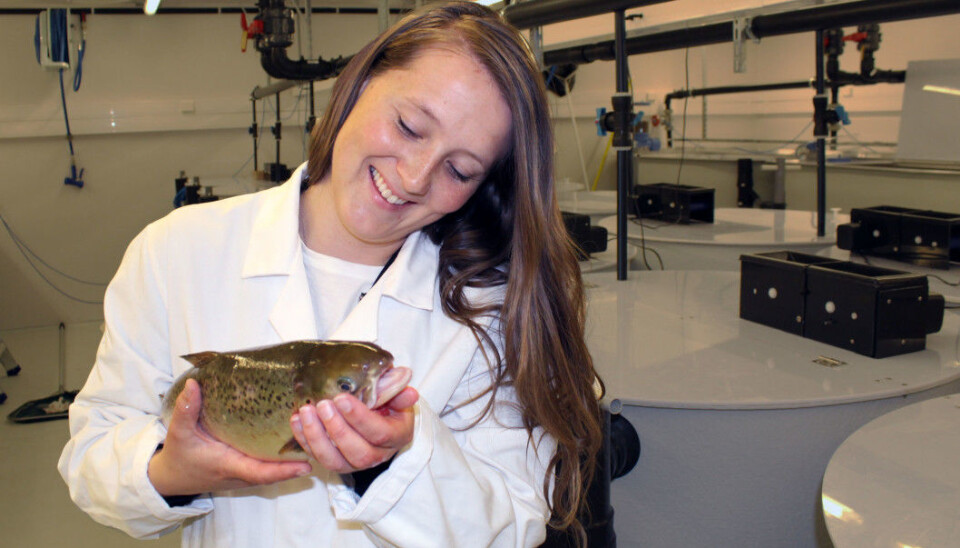
How scientists discovered salmon that need less food to grow
Norwegian researchers have identified young salmon that can be farmed using less feed than their not-as-efficient brethren.
With its long coastline and protected, deep fjords, Norway has always been a nation where fish are an important part of the economy, whether wild-caught or farmed.
It is in fish farming, however, where the nation is setting new records. In 2018, for example, Norway exported 10 billion euros worth of seafood, of which aquaculture accounted for about 70 percent of the value.
Although aquaculture is mature as an industry, there is still room for advances in production, particularly when it comes to fish food. Farmed salmon have been bred over the decades to convert feed efficiently, but there is room for improvement, researchers agree.
"The goal is to produce as much fish meat as possible with the least amount of fish feed," says Professor Gunnar Klemetsdal at the Norwegian University of Environmental and Life Sciences (NMBU).
Finding the most efficient fish
Recently, researcher Hanne Dvergedal was able to identify which salmon individuals use feed more efficiently than others, by analysing the content of specially labeled feed in the salmon's muscles, liver and fat. She recently earned her doctorate on the topic at NMBU.
"This is an important step in our efforts to produce salmon that use less feed," says Klemetsdal. He was Dvergedal's supervisor and has studied the efficient use of fish feed by salmon for many years.
Breeding for efficiency
Ever since Norway’s aquaculture industry started in the 1970s, scientists have selectively bred salmon with specific characteristics. They have bred fast-growing salmon that are robust and can withstand different fish diseases.
Today's farmed salmon usually can be harvested after about a year, when they weigh about five kilos. But Dvergedal’s discovery suggests this can be reduced even further.
"There is a lot of money to save on feed by getting the salmon up to slaughter weight with the fewest possible feeding days," Klemetsdal explains.
Feed efficiency and growth
But a large proportion of the genetic variation in how efficient a salmon is in using feed is due to factors other than growth, Klemetsdal says.
For example, some salmon eat more feed than others, but use the extra energy that results to swim more or replace more cells in the body, rather than growing.
"So there is room for improvement," he says.
Very expensive fish food
The trick in making improvements, of course, is identifying which of the hundreds of thousands of salmon produced each year use feed optimally to grow.
This is not a trivial undertaking. Figuring out how much food an individual fish actually eats is extremely challenging. You can't actually see how much individual farmed salmon eat.
So Dvergedal found a way to attach a label to the food that was fed to the farmed fish, a label that could be identified in the salmon meat after the fish were slaughtered.
The solution was to use specially made feed of spirulina, which is protein-rich algae. It was grown with carbon and nitrogen isotopes and could thus be traced in the salmon meat after the salmon were slaughtered.
Carbon and nitrogen isotopes have the same properties as ordinary carbon and nitrogen, but have different numbers of neutrons in the nucleus. This makes them traceable.
"We bought half-a-kilo of spirulina feed for a million kroner, which we picked up at the Oslo Airport," says Klemetsdal. That would be like buying 10 cans of specially labeled cat food for 100 000 euros.
Found the most efficient salmon
When the young salmon were slaughtered, Dvergedal analysed each fish's liver, muscles and adipose tissue for the content of isotopes.
The meat from most efficient salmon had the fewest isotopes for the same amount of weight gain.
"That is, these individuals used more of their feed to grow," she explains.
A total of 2,300 young salmon from freshwater tanks in Ås were used for the studies.
These were fish from 23 families, with 100 individuals in each family. The salmon were slaughtered when they weighed between 50 and 100 grams. Dvergedal and her colleagues will soon start trials with larger fish in cages.
By selectively breeding fish that have been identified as being extremely efficient at converting feed into meat, more salmon can reach the desired slaughter weight with less feed. Over the long term, this could mean a huge savings for the industry.
«One per cent decrease in feed use is a savings of 23 million euros for the Norwegian fish farming industry,» says Dvergedal.
------
Read the article in Norwegian at forskning.no































